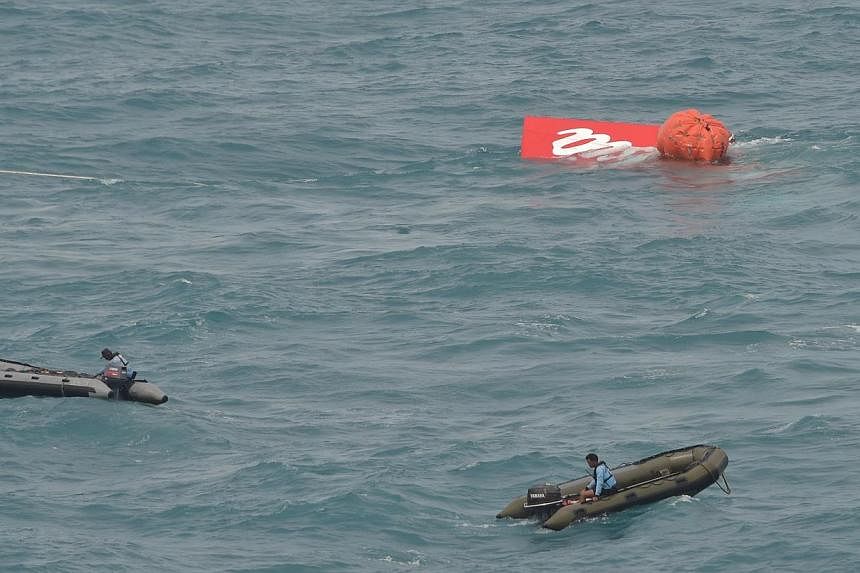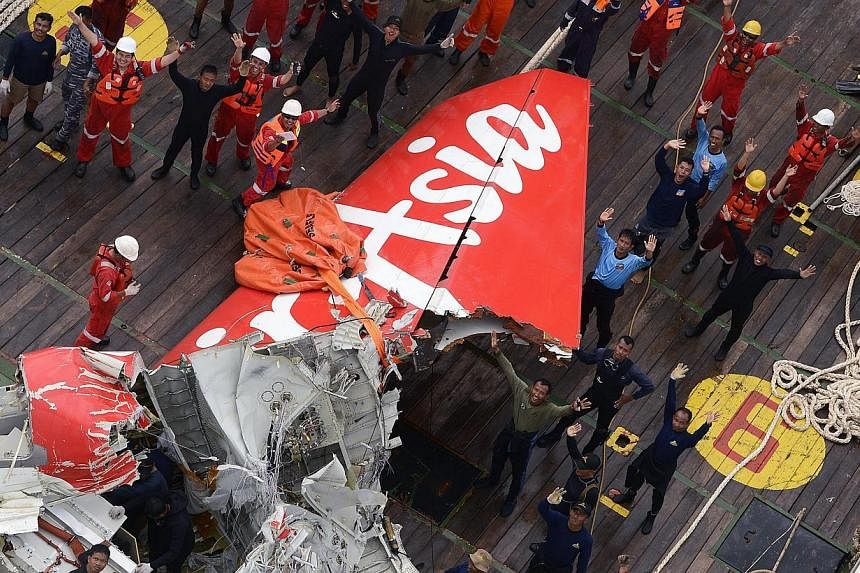ABOARD KRI BANDA ACEH, Indonesia (AFP) - The tail of an AirAsia plane that crashed into the Java Sea was lifted to the surface using floating balloons on Saturday, but apparently without the crucial black box recorders, Indonesian authorities said.
Flight QZ8501, carrying 162 people, went missing in stormy weather on Dec 28 as it flew from the Indonesian city of Surabaya to Singapore, and all aboard died.
The tail, which is where the black box data recorders were kept, was found in the seabed 30 metres below the surface and was finally lifted on to a vessel on Saturday using giant floating balloons and a crane.
"We have lifted the tail onto the ship. It's red and white and a big part of the AirAsia logo can be seen," Navy spokesman Manahan Simorangkir told AFP.
On board the KRI Banda Aceh that is one of the Indonesian Navy vessels involved in the search effort, sailors cheered as the tail first emerged at the surface, according to an AFP photographer on board.
The tail is the biggest part of the plane's wreckage found and could give clues to why it crashed. But the black boxes, which are crucial to explaining the disaster as they should contain the pilots' final words as well as various flight data, had likely been dislodged from the tail, according to S.B Supriyadi, a director with the National Search and Rescue Agency.
Pings from the boxes were detected on Friday, raising hopes of quickly retrieving them.
- Frustrating twist -
But the search took a frustrating twist when authorities realised the pings were likely coming from elsewhere than the tail, and the boxes appeared to be buried deep into the sea floor.
"Last night, our divers had opened the door of the tail cabin, searched around but found nothing," Supriyadi told AFP on Friday morning. "But the boat above detected faint ping sounds believed to be from the black boxes about one mile (1.6 kilometres) southeast of the tail... and covered in mud."
Supriyadi said the divers, from an elite Marines unit, returned on Saturday morning to the area believed to be where the pings were emanating from. "They are searching within a radius of 500 metres from where the pings are emitted. The challenge is that these sounds are very faint. If a ship passes by, the sounds will be drowned out. So we really need calm waters," he said.
"So far, our divers still have not been able to determine the coordinates of the black box."
After the tail was found, Supriyadi said authorities remained confident the black boxes remained underwater.
"There's a team examining the tail again to see if the black boxes are not there," he told AFP. "But the chances they might find anything there are slim. We still strongly believe that the black boxes are in the sea and our divers are still searching for them."
Meanwhile, search efforts also involving foreign naval ships continued for other parts of the plane's wreckage, as well as for the bodies of the passengers and crew.
Just 48 bodies have been found so far, according to Indonesian authorities. All but seven of those on board were Indonesian.
The non-Indonesians were three South Koreans, one Singaporean, one Malaysian, one Briton and a Frenchman - co-pilot Remi Plesel.
The Indonesian meteorological agency has said weather was the "triggering factor" for the crash, with ice likely damaging the engines of the Airbus A320-200.
Before take-off, the plane's pilot, Captain Iriyanto, had asked for permission to fly at a higher altitude to avoid a major storm. But the request was not approved due to other planes above him on the popular route, according to AirNav, Indonesia's air traffic control.
In his last communication, the experienced former air force pilot said he wanted to change course to avoid the storm. Then all contact was lost, about 40 minutes after take-off.



